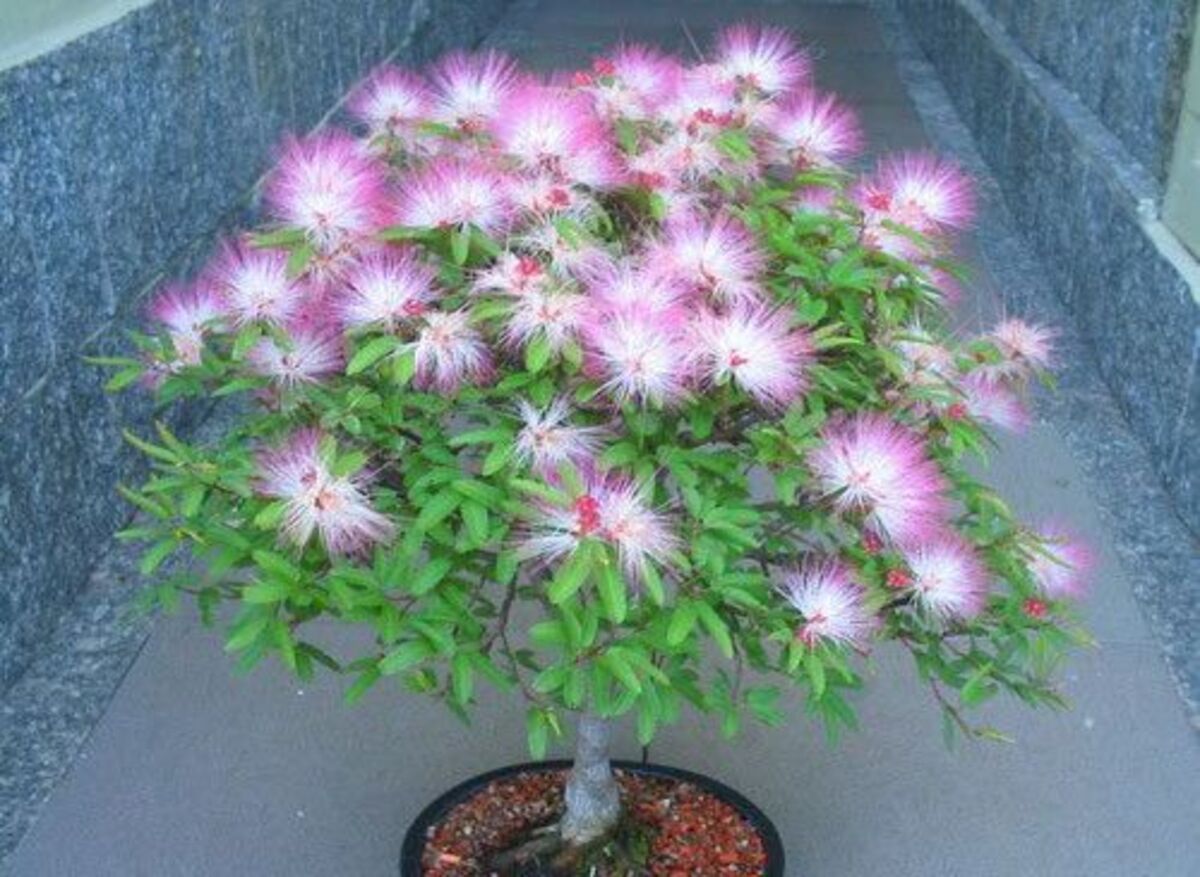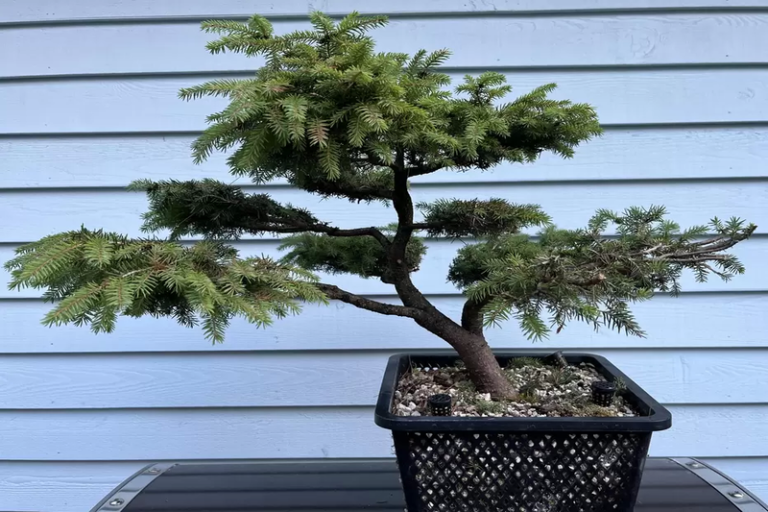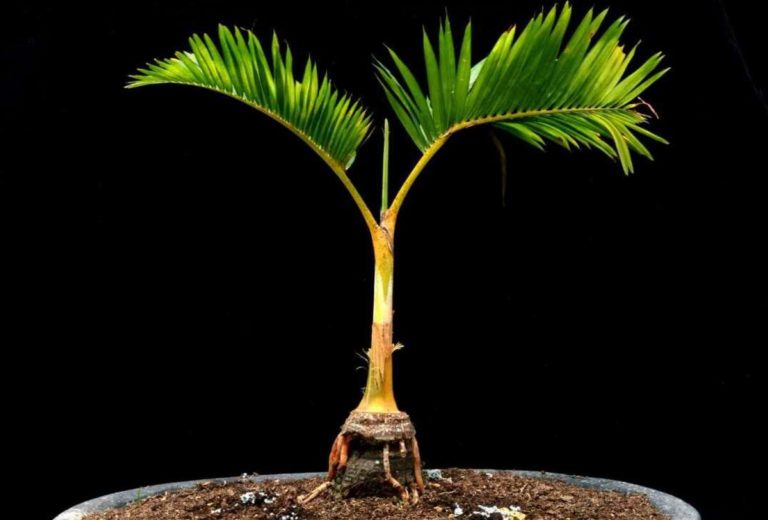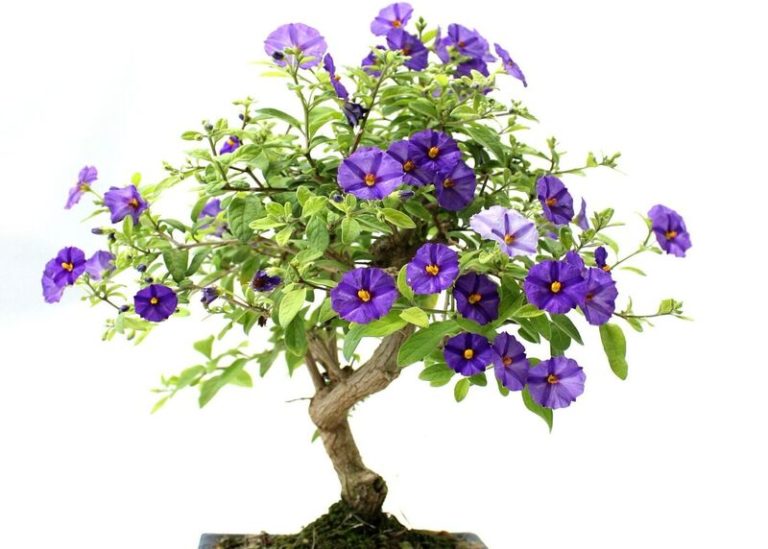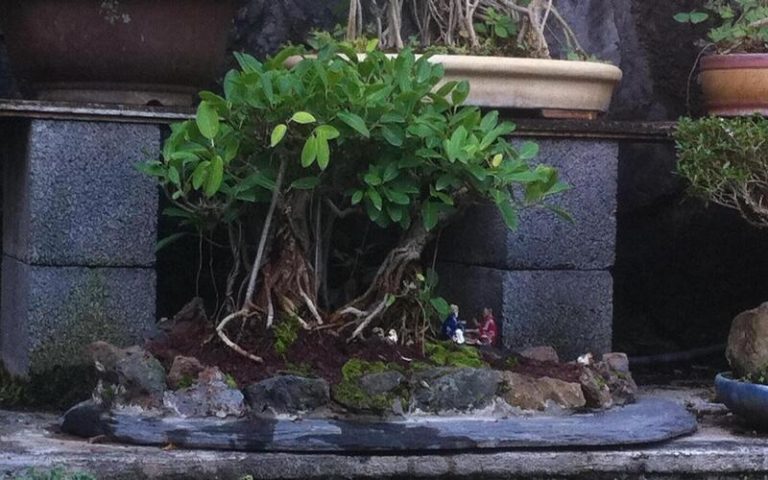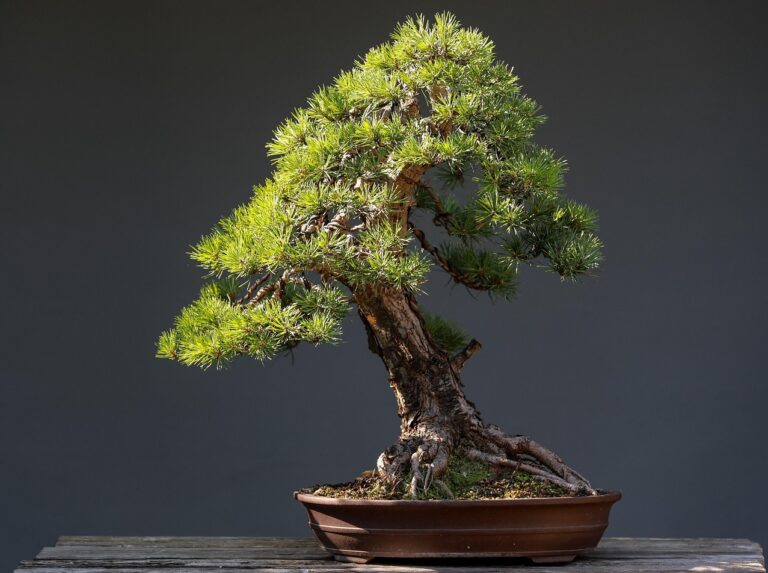Powder Puff Bonsai : A Blooming Wonderland in Miniature Form
Bonsai, the ancient art of cultivating and shaping miniature trees, holds a unique charm that has captivated people for centuries. Among its many fascinating variations, the Powder Puff Bonsai stands out for its delicate beauty and captivating blooms.. In this article, we will explore the beauty and care of Powder Puff Bonsai, perfect for those who appreciate delicate and unique plants.
What is a Powder Puff Bonsai?
A Powder Puff Bonsai is a type of bonsai tree that features the Calliandra plant species, commonly known as the Powder Puff plant. It is a unique variation of bonsai that captivates with its delicate and fluffy flowers. The tree itself has small, delicate leaves, adding to its overall charm. Powder Puff Bonsai stands out among other bonsai trees due to its distinct appearance and captivating beauty. It requires specific care and attention to maintain its miniature form and showcase its unique characteristics.
History and Origins of the Powder Puff Bonsai
The background of the Powder Puff Bonsai can be traced back to the old art of bonsai, which started in China and Japan. Bonsai, which means “tray planting,” has been done for hundreds of years as a way to grow and shape small trees in pots.
The art of bonsai began roughly 2,000 years ago in China, when it was primarily utilized for medical purposes and to create aesthetic landscapes. It eventually made its way to Japan, where it became profoundly engrained in the society and grew into a polished art form.
The art of bonsai originated in China some 2,000 years ago, where it was primarily utilized for medical purposes and to create aesthetic landscapes. It eventually migrated to Japan, where it became profoundly engrained in the society and matured into a polished art form.
Within the realm of bonsai, different plant species were explored and cultivated. One of these species was the Calliandra, known for its fluffy and vibrant flowers. This led to the creation of the Powder Puff Bonsai, which showcases the unique beauty of the Calliandra plant in miniature form.
The specific details of when and by whom the Powder Puff Bonsai was first cultivated and recognized as a distinct variation are not well documented. However, it is through the ongoing experimentation and creativity of bonsai enthusiasts and artists that the Powder Puff Bonsai has become a cherished and sought-after addition to the bonsai world.
Even now, the delicate flowers and general beauty of the Powder Puff Bonsai are still admired. It shows how bonsai as an art form has changed over time and has a long past. It also shows how ordinary trees can be turned into amazing live works of art.
Powder Puff Bonsai and Their Symbolism
Powder Puff Bonsai, like many other types of bonsai trees, can carry symbolic meaning and significance. The symbolism associated with Powder Puff Bonsai is rooted in the broader symbolism of bonsai as a whole as well as the unique characteristics of the plant itself. Here are some aspects of symbolism often attributed to Powder Puff Bonsai:
1. Beauty and Delicacy: The fluffy and vibrant flowers of the Powder Puff Bonsai symbolize beauty and delicate nature. They represent our appreciation of the small and intricate details in life, reminding us to find beauty in simplicity.
2. Patience and Time: Bonsai cultivation requires patience and time, as the trees are meticulously shaped and trained over many years. Powder Puff Bonsai symbolizes the virtue of patience and the rewards that come with investing time and effort into nurturing something over the long term.
3. Balance and Harmony: Bonsai is an example of how humans and nature can work together to create balance and unity. The Powder Puff Bonsai is small to show that the tiny tree and its surroundings can live together in peace. It reminds us to try to find balance in our own lives and to treat the wild world with care.
4. Tranquility and Zen: Bonsai is often associated with Zen philosophy and the pursuit of inner peace. The contemplative nature of tending a Powder Puff Bonsai can evoke a sense of tranquility and mindfulness, allowing one to find solace and connect with nature on a deeper level.
5. Longevity and Wisdom: When looked for properly, some bonsai plants, like the Powder Puff Bonsai, can live for many years. They are a sign of life, strength, and the knowledge that comes with getting older. They serve as a lesson to respect the wisdom that comes with getting older and to enjoy the road of personal growth.
It’s important to note that symbolism can vary among different cultures and individuals. While these interpretations are common, personal perspectives and cultural backgrounds can influence the symbolism attached to Powder Puff Bonsai. Ultimately, the symbolism of a bonsai tree is a personal and subjective experience that can hold different meanings for each observer.
Characteristics of the Powder Puff Bonsai
The Powder Puff Bonsai possesses several unique characteristics that make it a captivating and distinctive addition to the world of bonsai. Let’s explore these defining features:
- Calliandra Plant: The Powder Puff Bonsai is cultivated from the Calliandra species, commonly known as the Powder Puff plant. This plant is characterized by its fluffy and vibrant flowers, which resemble puffs of powder. These eye-catching flowers add a touch of whimsy and charm to the bonsai.
- Delicate Foliage: Powder Puff Bonsai leaves are tiny and delicate. They give the tree a beautiful and elegant aspect. The foliage is often rich and vivid green, adding to its aesthetic attractiveness.
- Fluffy Flowers: The Powder Puff Bonsai is most easily recognized by its unique flowers. The flowers are round or pom-pom-shaped, and they are made up of many tiny stems that make them look fluffy and fuzzy. The different shades of red, pink, and white in the flowers make the bonsai more colorful.
- Miniature Size: The Powder Puff Bonsai is grown and taught to stay small, like all bonsai plants. It is a great example of the art of downsizing, with all of its branches, leaves, and flowers shrunk down to make a small, beautiful tree. Its small size makes it easy to show and put anywhere, indoors or outdoors.
- Unique Aesthetics: The overall aesthetics of the Powder Puff Bonsai make it stand out among other bonsai varieties. The combination of delicate foliage, fluffy flowers, and small stature creates a visually striking composition. It exudes a sense of charm, elegance, and natural beauty that captures the attention and admiration of onlookers.
- Evergreen Nature: Most Calliandra species, which are the base of Powder Puff Bonsai, have leaves that stay green all year. This means that the bonsai keeps its leaves all year long, giving it a lush, green look even during the winter.
These characteristics collectively contribute to the appeal and allure of the Powder Puff Bonsai. Its delicate foliage, fluffy flowers, and miniature size make it a captivating addition to any bonsai collection, inviting admiration for its unique beauty and artistry.
Types of Powder Puff Bonsai
There are several types of Powder Puff Bonsai, each showcasing variations in flower color, leaf size, and growth habits. Here are some notable types of Powder Puff Bonsai:
Calliandra haematocephala: This type of Powder Puff Bonsai has bright red flowers that stand out against the plant’s green leaves. The flowers grow in groups that look like spheres. This makes for a colorful and eye-catching show.
Calliandra surinamensis: The pink flowers on this type of Powder Puff Bonsai are well-known. The tiny pink flowers add a soft, elegant touch to the bonsai, making it a pleasing piece to look at.
Calliandra tweedii: This type has flowers that are white or cream-colored, giving it a clean look. The bonsai feels calm and peaceful because of the white flowers.
Calliandra schultzei: This type of Powder Puff Bonsai is distinguished by its pale pink to light lavender flowers. The subtle and gentle hues of the flowers add a touch of elegance and grace to the bonsai.
Calliandra eriophylla: This variety features pink to coral-colored flowers. The vibrant and warm tones of the blooms bring a lively and cheerful ambiance to the bonsai.
It’s important to note that different species and cultivars within the Calliandra genus may exhibit slight variations in flower color and growth patterns. Additionally, bonsai enthusiasts and growers often experiment with hybrid varieties and selective breeding to introduce new and unique types of Powder Puff Bonsai.
Choosing which type of Powder Puff Bonsai to grow comes down to personal taste and the look you want to achieve. Each type has its own charm and personality, giving the Powder Puff Bonsai group a wide range of choices.
How to Grow a Powder Puff Bonsai
Growing a Powder Puff Bonsai requires careful attention to its specific needs and cultivation techniques. Here are some steps to guide you in growing a healthy and beautiful Powder Puff Bonsai:
Selection of Species and Cultivars:
- Choose a suitable Calliandra species or cultivar for your Powder Puff Bonsai. Consider factors such as flower color, growth habit, and climate suitability.
Soil and Pot Selection:
- Use well-draining soil specifically designed for bonsai cultivation. A mixture of akadama, pumice, and lava rock is commonly used.
- Select a bonsai pot with proper drainage holes to ensure excess water can escape.
Planting and Repotting:
- Carefully remove the young Powder Puff Bonsai from its nursery container and gently loosen the roots.
- Place the bonsai in the new pot, ensuring the roots are spread evenly. Add bonsai soil around the roots, gently pressing it to secure the tree.
Light and Temperature:
- Place the Powder Puff Bonsai in a location with bright, indirect light. Avoid direct sunlight, as it may scorch the leaves.
- Maintain a suitable temperature range for the specific Calliandra species, usually between 60 and 85°F (15 and 29°C).
Watering:
- Water the bonsai thoroughly when the soil starts to feel slightly dry, but avoid overwatering.
- Ensure the water reaches all parts of the root system. Allow the excess water to drain completely.
Pruning and Shaping:
- Regularly prune the Powder Puff Bonsai to maintain its desired shape and size. Remove any dead or diseased branches.
- Pinch back new growth to encourage branching and foliage density.
Fertilization:
- Apply a balanced, slow-release bonsai fertilizer according to the package instructions. Fertilize during the growing season (spring to fall) and reduce or stop fertilization during the winter.
Pest and Disease Control:
- Monitor the bonsai regularly for pests like aphids or spider mites. Treat infestations promptly using appropriate methods or insecticides.
- Take preventive measures to ensure good air circulation and avoid overwatering to minimize the risk of fungal diseases.
Winter Care:
- Protect the Powder Puff Bonsai from freezing temperatures. Move it to a sheltered location or use protective coverings if necessary.
- Reduce watering during the winter months, allowing the soil to partially dry out between waterings.
Regular Maintenance and Care:
- Continuously monitor the health of the bonsai, checking for signs of stress, nutrient deficiencies, or overgrowth.
- Prune and shape the bonsai as needed, and provide ongoing care with appropriate watering, fertilizing, and pest control.
Remember, growing a Powder Puff Bonsai requires patience and dedication. Regular care and attention will help you cultivate a stunning and thriving bonsai tree that showcases the unique beauty of the Powder Puff plant.
Benefits of the Powder Puff Bonsai
The Powder Puff Bonsai offers several benefits to bonsai enthusiasts and plant lovers alike. Let’s explore some of the advantages of cultivating and enjoying a Powder Puff Bonsai:
Aesthetic Appeal: The Powder Puff Bonsai’s unique and delicate flowers, combined with its miniature size, create a visually captivating and charming presence. It adds beauty and natural elegance to any indoor or outdoor space, enhancing the overall aesthetics of your home or garden.
Stress Relief and Relaxation: Caring for a Powder Puff Bonsai can be a therapeutic and calming activity. Engaging in bonsai cultivation, such as pruning, shaping, and tending to the tree’s needs, allows for a mindful and meditative experience. It provides a break from daily stress and promotes a sense of relaxation and tranquility.
Connection with Nature: The Powder Puff Bonsai brings nature into your living space, providing a connection to the natural world. Its presence can uplift moods, improve indoor air quality, and create a soothing ambiance, promoting a sense of well-being and harmony.
Cultivation of Patience and Discipline: How to Grow a Powder Puff Bonsai is an art form that takes patience because bonsai trees grow slowly over time. It teaches patience, control, and how important it is to care for something over time. By creating and teaching the tree, you learn to pay attention and concentrate.
Artistic Expression: Bonsai, including the Powder Puff Bonsai, is a form of living art. It allows you to express your creativity and artistic vision through the shaping and design of the tree. Each bonsai becomes a unique masterpiece, reflecting your personal style and aesthetic preferences.
Learning and Skill Development: How to Grow a Powder Puff Bonsai gives you a chance to keep learning and improving your skills. As you try out different techniques, like cutting, wiring, and styling, you learn more about gardening and growing bonsai. It can be a satisfying way to grow and get better.
Conversation Starter and Gift Option: The distinctive appearance of the Powder Puff Bonsai often sparks curiosity and conversation. It serves as an intriguing centerpiece or focal point, initiating discussions about bonsai, nature, and the art of miniature trees. Additionally, a well-cared-for Powder Puff Bonsai can be a unique and thoughtful gift for friends, family, or bonsai enthusiasts.
These benefits make the cultivation and enjoyment of a Powder Puff Bonsai a rewarding and enriching experience. From its visual allure to its therapeutic qualities, the Powder Puff Bonsai offers a range of advantages that can enhance your living space and bring joy to your daily life.

Displaying and Showcasing the Powder Puff Bonsai
Displaying and showcasing the Powder Puff Bonsai is an opportunity to highlight its unique beauty and create an aesthetically pleasing presentation. Here are some tips to help you showcase your Powder Puff Bonsai effectively:
- Selecting a Display Area: Choose a location that provides suitable lighting conditions for your Powder Puff Bonsai. Ideally, it should receive bright, indirect light to promote healthy growth and flower production. Avoid placing it in direct sunlight, as it may scorch the leaves.
- Bonsai Stands or Tables: Consider using a bonsai stand or table to elevate and highlight your Powder Puff Bonsai. These stands can be made of wood, metal, or other materials, and they provide a stable and visually appealing platform for displaying your bonsai.
- Positioning: Place the bonsai at eye level or slightly lower to let observers to notice its exquisite intricacies and overall composition. Place it such that it can be seen from all sides and rear.
- Accent Elements: Enhance the presentation of your Powder Puff Bonsai by incorporating accent elements. You can use decorative rocks, moss, or small figurines to create a miniature landscape that complements the bonsai. These elements can add visual interest and create a harmonious setting.
- Bonsai Pots: Choose a pot for your Powder Puff Bonsai that fits its size and style. The pot should be the right size for the tree, and its color and shape should add to the tree’s general look.
- Rotation: Periodically rotate your Powder Puff Bonsai to ensure balanced growth and prevent it from leaning or developing a one-sided appearance. This will also allow viewers to appreciate the tree from different angles and perspectives.
- Bonsai Display Events and Exhibitions: Consider participating in bonsai display events or exhibitions to showcase your Powder Puff Bonsai to a wider audience. These events provide an opportunity to learn from fellow enthusiasts, receive feedback, and gain exposure for your bonsai.
- Photography: Capture the beauty of your Powder Puff Bonsai through photography. High-quality photographs can be shared with others, displayed in your home, or used for documentation and reference purposes.
Make sure to take care of and manage your Powder Puff Bonsai on a daily basis to keep it healthy and strong. Keep the display area clean, pick up any fallen leaves or other trash, and move things around as needed to make a show that looks good. With care and attention to detail, you can show off the unique beauty of your Powder Puff Bonsai and share it with others.
Styling and Design of Powder Puff Bonsai
The styling and design of a Powder Puff Bonsai involve shaping the tree’s branches, foliage, and overall form to create a visually appealing and harmonious composition. Here are some guidelines to help you style and design your Powder Puff Bonsai:
Research and Inspiration: Begin by studying the natural growth patterns of the Powder Puff plant and observing mature specimens. Look for inspiration in bonsai books, magazines, and online resources to understand different bonsai styles and design principles.
Bonsai Styles: Choose a bonsai style that complements the characteristics of your Powder Puff Bonsai. Some common styles include formal upright, informal upright, cascade, semi-cascade, slanting, and windswept. Consider the tree’s trunk line, branch structure, and overall balance when selecting a style.
Primary Branches: Find the main parts that make up the structure of the tree. Choose stems that spread out in different directions to make an image that is open and well-balanced. Remove any stems that meet or compete with each other and make the design look bad as a whole.
Wiring and Shaping: Use bonsai wire to form and guide the growth of the branches in a gentle way. Bend the wire slowly and smoothly to avoid putting too much stress on it and hurting the trees. Shape the branches to give the tree a sense of growth and movement.
Branch Pruning: Trim the branches regularly to keep them in the shape you want and to encourage ramification, which is the growth of smaller limbs. Cut back any long or unwanted shoots, making sure that the plant always looks balanced. Make sure your bonsai tools are sharp so you can make clean cuts.
Foliage Density: Encourage a dense and compact foliage pad by pinching back new growth. This technique promotes branching and results in a fuller and more refined appearance. Be selective in removing leaves to maintain a balanced distribution throughout the tree.
Nebari and Root Pruning: Nebari refers to the roots on the top of the bonsai that add to its general look. As the tree grows, check and trim the roots every so often to help the nebari grow and spread out. When repotting, use root trimming methods to keep the roots healthy.
Patience and Regular Maintenance: Styling and Designing a Powder Puff Bonsai is an ongoing process that requires patience and regular maintenance. Monitor the tree’s growth, adjust the wiring as needed, and continue shaping and refining the design over time. Bonsai styling is a journey that evolves as the tree matures.
Remember, each Powder Puff Bonsai has its own unique characteristics and growth patterns. Embrace the natural beauty of the tree and work with its inherent qualities to create a bonsai that reflects your vision and appreciation for the art form.
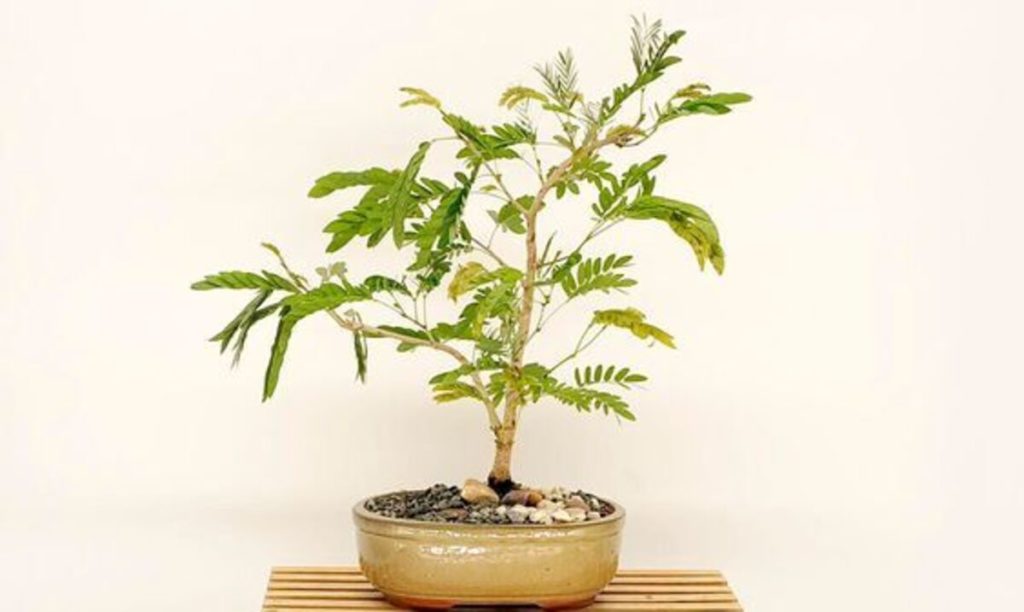
How to Care for and Maintain a Powder Puff Bonsai
Caring for and maintaining a Powder Puff Bonsai is essential to ensuring its health, vitality, and overall well-being. Here are some important care guidelines to help you keep your Powder Puff Bonsai thriving:
Watering:
- Water the bonsai thoroughly when the top inch of soil feels slightly dry. Use a watering can or hose with a fine nozzle to avoid disturbing the soil and roots.
- Ensure that water reaches all parts of the root system, but avoid overwatering, as it can lead to root rot. Allow the excess water to drain completely from the pot.
Light and Temperature:
- Place the Powder Puff Bonsai in a location with bright, indirect light. It prefers partial shade, especially during the hottest parts of the day.
- Maintain a suitable temperature range for the specific Calliandra species, usually between 60 and 85°F (15 and 29°C). Protect the bonsai from extreme temperatures and drafts.
Soil and Fertilization:
- Use well-draining soil specifically formulated for bonsai. A mixture of akadama, pumice, and lava rock is commonly used.
- Fertilize the Powder Puff Bonsai during the growing season (spring to fall) using a balanced, slow-release bonsai fertilizer. Follow the manufacturer’s instructions for dosage and application frequency.
Pruning and Shaping:
- Regularly prune the branches and foliage to maintain the desired shape and size of the bonsai. Remove any dead, damaged, or excessive growth.
- Use sharp and clean bonsai pruning tools to make precise cuts. Seal large wounds with cut paste to promote healing.
Wiring and Training:
- If necessary, use bonsai wire to shape and train the branches of the Powder Puff Bonsai. Apply the wire gently to avoid damaging the bark, and remove it once the branch has set in the desired position.
Pests and Diseases:
- Monitor the bonsai regularly for pests such as aphids, spider mites, or scale insects. Treat any infestations promptly using appropriate methods or insecticides.
- Ensure good air circulation around the bonsai to prevent the development of fungal diseases. Avoid overwatering, and remove any affected leaves or branches.
Repotting:
- Repot the Powder Puff Bonsai every 1-2 years, usually in early spring before the growing season begins. Use bonsai soil and carefully trim the roots during repotting to maintain a healthy root system.
Winter Care:
- Protect the Powder Puff Bonsai from freezing temperatures by moving it to a sheltered location or using protective coverings.
- Reduce watering during the winter months, allowing the soil to partially dry out between watering.
Regular Observation and Maintenance:
- Regularly observe the health and development of your Powder Puff Bonsai. Look for signs of stress, nutrient deficiencies, or pest infestations.
- Adjust your care routine accordingly and address any issues promptly to prevent further damage.
By following these care instructions and giving your Powder Puff Bonsai regular attention, you can make sure it stays healthy and beautiful for a long time. Keep in mind that each bonsai may have different needs depending on its species and surroundings, so it’s important to pay attention to and meet the needs of your tree.
Powder Puff Bonsai Care Sheet
| Aspect | Care Tips |
| Watering | Water thoroughly when the top inch of soil feels slightly dry. |
| Ensure proper drainage and avoid overwatering to prevent root rot. | |
| Sunlight | Place in bright, indirect light. Avoid direct sunlight, especially during the hottest parts. |
| Temperature | Maintain a temperature range between 60-85°F (15-29°C). |
| Humidity | Moderate humidity levels are generally suitable. |
| Fertilization | Apply a balanced, slow-release bonsai fertilizer during the growing season. |
| Follow the manufacturer’s instructions for dosage and frequency. | |
| Pruning and Trimming | Regularly prune to maintain desired shape and remove dead or excessive growth. |
| Use clean, sharp pruning tools and seal large wounds with cut paste. | |
| Wiring and Styling | Use bonsai wire to shape and train branches if necessary. |
| Apply wire gently to avoid damaging the bark and remove it once the branch sets. | |
| Repotting | Repot every 1-2 years in early spring using bonsai soil. |
| Trim the roots during repotting to maintain a healthy root system. | |
| Pest and Disease Control | Monitor regularly for pests such as aphids, spider mites, or scale insects. |
| Treat infestations promptly using appropriate methods or insecticides. | |
| Winter Care | Protect from freezing temperatures and provide shelter or coverings. |
| Reduce watering and allow soil to partially dry between waterings. | |
| Regular Maintenance | – Regularly observe the bonsai’s health and address any issues promptly. |
| Adjust care routine as needed and provide ongoing attention and care. |
Individual care needs for the Powder Puff Bonsai may vary significantly according on the species or cultivar, as well as your local climate and growth circumstances. To guarantee the tree’s well-being, it’s critical to carefully monitor it and alter its care as needed.
Conclusion
Powder Puff Bonsai shows how beautiful and skilled bonsai can be. It is a unique addition to any collection because of its tiny flowers and leaves. Taking care of a bonsai tree and watching it grow is a fun and satisfying thing to do. So, why not start the beautiful journey of growing a Powder Puff Bonsai and enjoy the beauty of nature in a small way?
FAQ
Q: What is a Powder Puff Bonsai?
A: A Powder Puff Bonsai is a miniature tree that is trained and shaped to resemble a full-sized Powder Puff plant (Calliandra species). It features delicate, pom-pom-like flowers that give it its name.
Q: How big do Powder Puff Bonsai trees grow?
A: Powder Puff Bonsai trees are typically small in size, ranging from 6 inches to 2 feet (15 cm to 60 cm) in height, depending on the specific species and the bonsai artist’s training and shaping techniques.
Q: Can Powder Puff Bonsai trees be kept indoors?
A: Yes, Powder Puff Bonsai trees can be kept indoors. They prefer bright, indirect light and moderate humidity. Ensure proper care, including suitable watering and temperature conditions, to maintain their health indoors.
Q: How often should I water my Powder Puff Bonsai?
A: Water your Powder Puff Bonsai when the top inch of soil feels slightly dry. Avoid overwatering, as it can lead to root rot. Ensure proper drainage and thoroughly drain the water, allowing excess water to drain completely.
Q: Do Powder Puff Bonsai trees require special soil?
A: Powder Puff Bonsai trees require well-draining soil specifically formulated for bonsai. A mixture of akadama, pumice, and lava rock is commonly used to provide adequate drainage and promote healthy root development.
Q: When should I fertilize my Powder Puff Bonsai?
A: Fertilize your Powder Puff Bonsai during the growing season, typically from spring to fall. Use a balanced, slow-release bonsai fertilizer and follow the manufacturer’s instructions regarding dosage and application frequency.
Q: Can I shape and prune my Powder Puff Bonsai?
A: Yes, shaping and pruning are important for maintaining the desired form and size of your Powder Puff Bonsai. Regular pruning helps promote branching and foliage density, while wiring can be used to shape and train the branches.
Q: How often should I repot my Powder Puff Bonsai?
A: Repot your Powder Puff Bonsai every 1-2 years, typically in early spring before the growing season begins. This allows for root pruning, refreshing the soil, and maintaining a healthy root system.
Q: What should I do during the winter to care for my Powder Puff Bonsai?
A: Protect your Powder Puff Bonsai from freezing temperatures by moving it to a sheltered location or using covers. Reduce watering during the winter and allow the soil to partially dry between watering to prevent root issues.
Q: Are there any common pests or diseases that affect Powder Puff Bonsai?
A: Powder Puff Bonsai can be susceptible to pests such as aphids, spider mites, and scale insects. Regularly inspect your bonsai for signs of infestation and treat them promptly using appropriate methods or insecticides.
Also Read:

